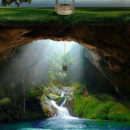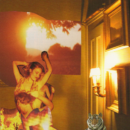Step Into The Inner Circle
Greetings Feng Shui Lovers!
WSFS is thrilled to announce that the Inner Circle content formally offered only by subscription is now COMPLIMENTARY!
 Here is a Table of Contents of our Inner Circle page:
Here is a Table of Contents of our Inner Circle page:
What is Essential Feng Shui?
Essential Feng Shui Made Easy
Philosophy of Essential Feng Shui® #1: Everything is Alive
Philosophy of Essential Feng Shui® #2: Everything is Connected
The Philosophy of Essential Feng Shui® #3: The Ch’i in Everything is Changing
Inner Essential Feng Shui®– The Sanctuary Within
And drop by our virtual Inner Circle Lounge for special content like audio programs, webinars, access to Terah’s book The Western Guide to Feng Shui for Romance, and more!
![]() Would you rather see this content in a social setting where you can connect with fellow Feng Shui lovers? We also post all of our Inner Circle articles on our Essential Feng Shui® and Western School of Feng Shui Facebook pages!
Would you rather see this content in a social setting where you can connect with fellow Feng Shui lovers? We also post all of our Inner Circle articles on our Essential Feng Shui® and Western School of Feng Shui Facebook pages!
Read More
Nourishing and Controlling the Five Elements
The Five Elements in Feng Shui
In Feng Shui, the elements Wood, Fire, Earth, Metal, and Water are considered the basic building blocks of everything physical on the planet. They manifest in countless ways and combinations all around us. Feng Shui observes that human beings are made up of all Five Elements, and therefore, we are most comfortable when they’re all present in our homes. The fastest way to learn how to work with the elements is to observe them in your home.
Although many people can sense when an environment is out of balance, they often don’t know exactly how to fix it. Would red or blue be good here? Should the table be round or rectangular? Is a mirror or artwork best there? Questions such as these are easily answered when you know how to read the elements, making them one of your most intriguing Feng Shui tools. Learn how to recognize and combine the Five Elements, and you’ll be able to see exactly what each room needs to bring it into perfect balance.
Five Element arrangements can be made in any room and can be any size that’s appropriate for the space. I often suggest that people put together an elemental arrangement of objects in areas that need energizing, such as a garage, spare bedroom, or basement. This positive action marks the beginning of change and stimulates the Ch’i so that it’s easier for people to organize these areas.

“Fire” collage by Terah Kathryn Collins
The Nourishing Cycle of the Five Elements
When you bring the Five Elements into a room, you are tapping into their Nourishing Cycle, where each element feeds and sustains the other in perfect harmony. Water sustains Wood; Wood feeds Fire; Fire makes Earth; Earth creates Metal; and Metal holds Water. The Nourishing Cycle shows us how the elements strengthen and nurture each other in an endless regenerating sequence. When all five are present in an environment, a natural balance is achieved.
The Controlling Cycle of the Five Elements

“Earth” collage by Terah Kathryn Collins
In the Controlling Cycle, we see how the elements dominate and control each other. In this cycle, Woodconsumes Earth; Earth dams Water; Water extinguishes Fire; Fire melts Metal; and Metal cuts Wood. The Controlling Cycle is regarded as a powerful guide for establishing elemental harmony, and is present in many of the places we consider the most beautiful. A palm tree oasis in the desert is a perfect example of Wood consuming Earth, while a tropical island in crystal-clear water is essentially Earth damming Water. Nature constantly provides us with examples of how the Controlling Cycle of the elements can create harmony and beauty.
It’s also very useful to be aware of the Controlling Cycle when you’re balancing the elements in your home. When one element is especially dominant, the Controlling Cycle will show you the element that can quickly balance the Ch’i. Once you have balanced the dominant element with its controlling partner, you can turn to the Nourishing Cycle and further refine your elemental
work.

“Metal” collage by Terah Kathryn Collins
I worked with a home where the living room was dominated by Earth. The decor included square tile floors, stucco walls, dark beige-checked couches, brown chairs, small square area rugs in various earthtones, and many small earthenware accessories. The furniture was arranged in a tight square around a large rectangular table made up of ceramic tiles. On the wall behind the sofa hung a painting of the desert. So much Earth gave the space a heavy, boxed-in feeling, which matched the way the owners felt in their home.
To balance the Earth, they needed to first introduce the element that controlled Earth, which is Wood. They added turquoise pillows to the sofa, a large textured rug in blues and greens beneath the coffee table, and several large plants. Turning to the Nourishing Cycle, they fed the Wood element with Water by replacing their desert painting with a large mirror and adding a small tabletop waterfall. They also introduced the Metal element by framing that mirror in a gilt frame and arranging the plants in round metal pots. Lamplight, natural light, and touches of coral painted on their ceramics brought in plenty of Fire, which by nature strengthens Earth.
They also opened up the boxy “Earthy” furniture

“Water” collage by Terah Kathryn Collins
arrangement by turning the two brown chairs at a diagonal, giving them a peripheral view of the door. As a finishing touch, they ran a turquoise table runner diagonally across the coffee table to soften two of the corners. With these changes, their once-constricted living room became very comfortable, inviting a more spontaneous and enjoyable lifestyle.
Elemental extremes abound in our architecture and rooms.
Monochromatic motifs, and the constant repeating of one shape, are two things I often see in people’s homes. Although the effect may be perceived as quite trendy or dramatic, most people will not find comfort there, because on the elemental level, one is dominating while the others are missing. Remember, your ultimate goal is to bring all Five Elements into balance in every
room. It’s remarkable to witness the difference this makes in the perceived comfort of a room.
You’ll find much more information on the Five Elements in Terah’s book The Western Guide to Feng Shui, Room by Room.
Read More
Making a Splash! Coloring the Five Elements
By Karen Abler Carrasco
 We recently had a questions about elemental colors- why is blue associated with Wood and not Water? Teacher, Practitioner, and WSFS alum Karen Abler Carrasco explains:
We recently had a questions about elemental colors- why is blue associated with Wood and not Water? Teacher, Practitioner, and WSFS alum Karen Abler Carrasco explains:
Q: I feel confused about the color blue being associated with the wood element. I want to associate it with the water element.







